|
|
 |

Sustainable Urban Tourism Destination Management: The Cases of Klong Khwang and Phimai,
Thailand
Walter Jamieson, PhD
Professor, Urban Environmental Management Program, AIT
Director, CUC-AIT UEM Training and Technology Transfer Program (TTTP)
Andrea Czarnecki, MEDes
Coordinator, CUC-AIT UEM TTTP
Summary
This paper outlines experiences in the CUC-AIT UEM Training and Technology Transfer
Program's (TTTP) sustainable urban tourism destination management focus area. The cases of
Phimai and Klong Khwang provide a context for the discussion of challenges, instruments,
potential solutions, and issues in bringing the rhetoric of sustainable tourism
development down to the level of grounded practice. The paper concludes by identifying
some of the key questions central to processes of culturally appropriate, environmentally
sound, and economically viable tourism destination management.
Preface
This paper has been written for the Thailand Urban Cultural Heritage Workshop and
assumes that the issues of urban heritage and the economic development dimensions of urban
heritage had been discussed by Charles Landry and Douglas Webster respectively. We have
therefore chosen not to include conceptual discussions of these two issues.
Background
Funded by the Canadian International Development Agency (CIDA), the TTTP is a
partnership venture involving the Asian Institute of Technology (AIT), Thailand, and the
Canadian Universities Consortium (1) (CUC). With its
focus on training and demonstrations in urban environmental management, the TTTP is a
solutions-oriented project that addresses the challenges of urban growth in Southeast
Asia. An essential feature of the TTTP is its recognition of the importance of cooperation
and collaboration between communities, public and private sectors, and NGOs for effective
urban environmental management. Underlying the TTTP are principles of gender equity and
community economic development.
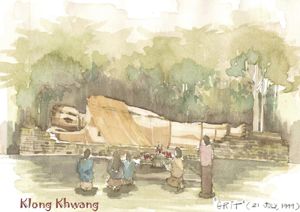 The over-arching CUC UEM Project focuses
on four demonstration areas: sustainable urban tourism destination management,
environmental impact assessment, clean production, and transportation planning. In the
environmental impact area the Project is assessing the cumulative environmental impacts of
present and future hotel development in Siem Reap, Cambodia, in cooperation with the
Cambodian Ministry of the Environment. In Hua Hin, Thailand, we are assessing cleaner
production techniques for reducing solid waste in the hotel industry. We have also
participated in training events in the Philippines with the Department of Tourism as well
as in Luang Prabang, Laos, where we have worked with tourism authorities. The over-arching CUC UEM Project focuses
on four demonstration areas: sustainable urban tourism destination management,
environmental impact assessment, clean production, and transportation planning. In the
environmental impact area the Project is assessing the cumulative environmental impacts of
present and future hotel development in Siem Reap, Cambodia, in cooperation with the
Cambodian Ministry of the Environment. In Hua Hin, Thailand, we are assessing cleaner
production techniques for reducing solid waste in the hotel industry. We have also
participated in training events in the Philippines with the Department of Tourism as well
as in Luang Prabang, Laos, where we have worked with tourism authorities.
As a TTTP focus area, sustainable urban tourism destination management is based on the
need to move from the rhetoric of sustainable development to locally grounded tourism
planning and management practices. Specifically, sustainable urban tourism destination
management explores the challenges of achieving economic benefits from sustainable
community tourism while mitigating its negative social, cultural and environmental
impacts. The concern is not to create more opportunities for the hotel and hospitality
industry. Rather, it recognizes tourism as a major force in community development that
must be carefully planned and managed according to principles of sustainability if
communities are to profit from tourism activities while nevertheless maintaining their
social, cultural and environmental integrity.
Through its demonstration and training activities (2), the TTTP "transfers" Canadian expertise,
techniques and experiences to Southeast Asian contexts; that is, Canadian practices are
appropriately adapted to locally-defined issues and objectives. In this way, the
groundwork is laid for participatory, replicable and sustainable environmental management
approaches and techniques.
In this paper we will examine the TTTP's sustainable urban tourism destination
management focus area. We will describe our demonstration experiences to date in two
northeastern Thai communities: Klong Khwang and Phimai.
Urban Heritage Defined
Urban heritage has a number of manifestations, including both tangible and intangible
factors.
 Tangible elements include: Tangible elements include:
- Museums
- Arts and crafts
- Historic sites
- Historic buildings and areas
- Dance
- Music
- Theatre
- Festivals
- Cultural landscapes
- Rituals
- Food & drink
- Languages
- Religion
- Notion of celebration
- Dress
- Costume
- Leisure activities
- Literature
Intangible factors include:
- Lifestyles
- Decision-making structures
- Sense of community
- Societal structures
- Traditions
- Values
- Religion
Ambient qualities can be composed of:
- Climate
- Noise
- Smells
- Quality of light
The Tourism Destination Management Challenge
Throughout Southeast Asia there is considerable pressure on communities to seek
alternative forms of economic development. In many instances tourism has been identified
as either a main or substantial source of employment and income generation. There are a
number of sustainable development issues related to tourism and one of the challenges of
sustainable urban tourism destination management is to help communities make effective
decisions relating to tourism development. While tourism is now the largest industry in
the world and has incredible potential for economic growth, it potentially carries with it
significant negative social and environmental impacts. The art of the management process
is to balance the costs and benefits for the community.
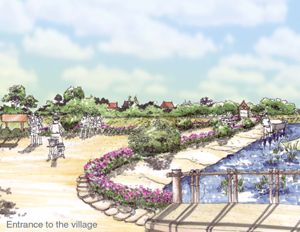 Cultural tourism can be seen to have a
number of positive impacts including the following: Cultural tourism can be seen to have a
number of positive impacts including the following:
- Enhancing the amenities of a region
- Building community pride
- Enhancing sense of identity
- Supporting the community economy
- Providing new employment opportunities
- Maintaining community stability
- Broadening community horizons
Negative tourism impacts that must be avoided are:
- Site-use conflicts (environmental, cultural, economic, visual)
- Regional disparities
- Culture commodification
- Higher cost of living
- Displacement of traditional residents
- Increased crime
- Undermining of local traditions and ways of life
- Pollution
- Pressure on services and facilities
Destination management seeks through an integrated approach to ensure viable and
sustainable development. Experience has shown that destinations must:
- Develop appropriate organizational and management structures that meet community
expectations
- Carry out a range of planning and design activities
- Be deeply involved in marketing
- See product development as an essential element of the overall tourism development
process
- Ensure that destination and site operations meet economic and environmental goals
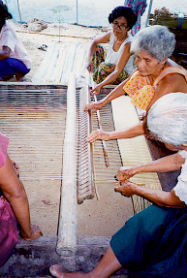 The destination management issue is being
further developed and will soon be available as an occasional paper published in the
Project's "Outreach Series." The destination management issue is being
further developed and will soon be available as an occasional paper published in the
Project's "Outreach Series."
For some communities the issue is how to capture economic development that will not
destroy their social, cultural and environmental heritage. In other communities, the
challenge is to develop management strategies that will allow them to increase their
tourism activities in order to support a range of community objectives.
There is no doubt that cultural resources of all kinds have the potential to create
wealth for a community and region while at the same time generating resources for the
conservation and interpretation of community and national heritage. The challenge is to do
this in a sustainable fashion.
Some of the greatest challenges for the TTTP are in achieving the objectives of
economic development, protection and interpretation of heritage resources, and the
sustainability of the social and environmental dimensions of the community.
Choosing the Demonstration Sites
During the initial phase of demonstration site selection, the TTTP worked closely with
the Tourism Authority of Thailand (TAT). Through their generous assistance, the
Bangkok-based TTTP team (3) visited numerous communities
and met with many local officials.
One of the issues we faced in choosing sites, not only in the tourism destination focus
area but in all our areas, was to find locations and situations where we could have an
impact on a community. Experience has shown us that work in large urban areas is difficult
to implement without a great deal of prior work and preparation. If the Project is funded
for another phase, we will continue to build on the demonstration projects. This will then
allow the Project to tackle issues in larger urban areas. When we were choosing sites and
working with the TAT it became clear that the opportunities for working in urban heritage
rested in smaller human settlements. Our position is that much of what we learn can be
transferred to larger urban settings.
The final selections of Klong Khwang and Phimai were informed by the
following key factors:
- Community interest and willingness to work with the TTTP
- Whether the sites formed or could form part of a tourism "circuit" (4)
- Did the TTTP have the appropriate capacity and resources to assist with
community-defined tourism issues and objectives?
- Ability to learn lessons and transfer experience to larger settings.
- Community-defined issues and objectives are of paramount importance as they contribute
to a process that is both culturally appropriate and empowering.
Klong Khwang
As a tourist destination, the 91-household village of Klong Khwang is still in its
formative stages. However, early discussions held with the local District Director and the
"Poo-yai Baan" (village headman) revealed a strong commitment to the following
community objectives:
- Develop and implement a tourism plan (5) based on
"village life," Thailand's largest stone reclining Buddha, and an unexcavated
archaeological city
- Develop income generation activities for community members (e.g., handicrafts, food
vending, village tours)
- Excavate the archaeological city and moat (under the direction of the Fine Arts
Department)
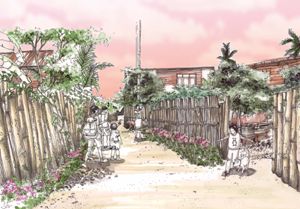 As a program based on technical rather
than financial assistance, the nature of the TTTP's role in Klong Khwang's tourism
development process became the subject of subsequent discussions. This, indeed, was a
learning process for all concerned. Based on these discussions, however, as well as a
TTTP-sponsored situational analysis, our role soon took shape at both government and
community levels. As a program based on technical rather
than financial assistance, the nature of the TTTP's role in Klong Khwang's tourism
development process became the subject of subsequent discussions. This, indeed, was a
learning process for all concerned. Based on these discussions, however, as well as a
TTTP-sponsored situational analysis, our role soon took shape at both government and
community levels.
At the government level, TTTP team members are assisting officials in a
capacity-building process of critical reflection on such factors as carrying capacity,
marketing, and social and environmental impacts – and specifically in terms of how
they relate to the community-defined tourism objectives. To facilitate this process, team
members are undertaking the following:
- Preparation of visual representations of strategic village sites as a guide to physical
development possibilities and encouraging participation
- Design of brochures and signage, where local officials are responsible for supplying
data (e.g., the "story" of Klong Khwang, signage wording, interpretation, etc.)
- Compilation of tourism themes and alternatives (including a "no-tourism"
option)
Identification of essential components of the final plan
Through these activities, TTTP members provide technical assistance but do not design
the community tourism plan – rather, this task is left to those who have stakes in
the outcome.
At the community level, this strategic approach to tourism planning,
which reinforces stakeholders' roles in the decision-making process, involves an
interesting exercise in community participation. Certainly, effective community
participation is essential as one of the defining principles of sustainable development.
Yet it is often the most difficult to carry out in practice. Responding to this challenge
and building on the apparent community readiness to embrace tourism, the TTTP team
conducted a full-scale mock "tourism day." (6)
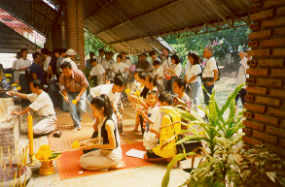 The tourism day had a series of
objectives: The tourism day had a series of
objectives:
- To provide the community with an opportunity to experience a flow of visitors in into
their community
- To provide residents with an opportunity to development different tourism experiences
- To provide residents with the opportunity to assess whether this level of tourism was
something they were prepared to accept over a long period time
- To test the community's infrastructure from a visitation perspective
- To evaluate the attractiveness of the message that the community wishes to transmit to
the visitor
In this exercise, the team (along with spouses, friends, and AIT graduate students)
posed as "tourists" for a day in Klong Khwang – with the activities
determined completely by the village headman and community members. From providing
English-speaking tour guides and planning an interesting sightseeing route/itinerary, to
preparing a large buffet lunch – the community proved to be extremely well organized:
all "tourists" had an enjoyable tour. Most importantly, however, the community
had a chance to experience the demands of a larger tourist group. This, in turn, provides
a basis for community discussions of such issues as:
- Desirability/undesirability of large tour groups
- Timing of visits
- Adequacy of present facilities and infrastructure
- Waste management
- Location of toilet facilities
- Distribution of economic benefits
- Impacts on daily village life
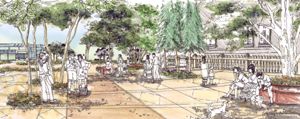 Early Findings and Issues Early Findings and Issues
One of the assumptions that the team had upon entering the planning process was that
the community objective was to improve the economic conditions of the community in general
and of individuals in particular. For the present time, however, the community is
satisfied with using the donations left by tourists for the maintenance and expansion of
the temple and to augment the revenues from the store run by the women's cooperative. This
presents a unique economic development challenge. Specifically, if community members are
expected to shoulder some of the costs associated with increased tourism activities (e.g.,
decreased privacy), then it may become increasingly important to ensure that they receive
some of the financial benefits as well.
Nine months into the process of assisting Klong Khwang with sustainable urban tourism
destination management, the activities and meetings conducted indicate a need to proceed
with a cautious and thoughtful approach. Indisputably a fragile community, large tour
groups in the village may be detrimental to both its environment and its patterns of
village life. Indeed, as an example of the latter, during the mock tour day a villager
removed her hat while working, explaining to our interpreter that this made her more
"presentable." While seemingly insignificant, such incidents hint at possible
changes to villagers' dress and lifestyles to accommodate their preconceived notions of
tourists' expectations.
The viability of tourism in Klong Khwang is thus a significant issue. A clear
understanding of the nature of both product and visitor, realistic expectations of tourism
revenues, and appropriate interpretive strategies and guide training are all factors that
must be considered prior to implementing any tourism strategy in the village. If, for
example, the tourism product is to be "traditional village life" (as has been
indicated by community leaders) then the community – which is itself dynamic –
must address the difficult challenge of maintaining its traditional, authentic character.
Further, if community members are expected to share in the costs of tourism (e.g.,
decreased freedom to renovate housing), then it is imperative that the financial benefits
be fairly distributed.
The task of maintaining the traditional and authentic character of the community's
buildings and layout is an interesting one. If tourism is successful and the resulting
economic gains spread to the general population, there will be resources for improving
both public as well as residential buildings. Some of the homes have already been
renovated with much of the traditional character hidden by modern improvements. The irony
is that as the community gets more money to spend on such things as home improvement they
will have to withstand such pressures in order to maintain the character of their
community that is a major part of the tourism product. How to do this cannot be the
subject of regulation but must rather be based on community agreement and persuasion.
Next Steps
(e.g., reintroducing the moat surrounding its un-excavated archeological city), the
need to encourage government and community discussions of carrying capacity and social and
environmental impacts is at the forefront of the TTTP's planned activities over the next
six months. Through such discussions, as well as computer-aided images of key points of
interest within the community and written accounts of tourism options (including a
"no tourism" option), the TTTP expects to act as a catalyst for dialogue and
action between the local community and government.
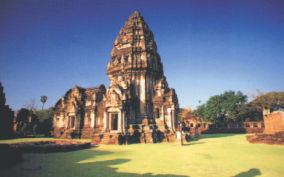 Phimai Phimai
The municipality of Phimai, however, is in a very different stage of tourism
development when compared with Klong Khwang. With an Angkor-period temple, annual
festivals, historic Banyan Tree, museum, restaurants, and two hotels, Phimai attracts
thousands of visitors annually. Thus, whereas Klong Khwang's tourism development process
is basically beginning with a clean slate, Phimai requires assistance with improving its
already established position as a cultural tourism destination.
Working primarily with the Ninth Regional Office of Archaeology and National Museums
(henceforth referred to as the "regional office"), the TTTP is focusing on very
specific objectives in Phimai. Based on discussions with regional office representatives,
these objectives include:
- Improved interpretation and preservation of the historical site
- Enhanced commercial street experiences to support additional economic activity
- Increased visitation rates to the museum
- Suggestions on how to address the issue of the encroachment of new buildings on the
sanctuary site, which impact the heritage and cultural experience
- Improved comfort levels in the museum
With the assistance of Canadian experts in interpretation and preservation, as well as
help from both Thai and Canadian students, efforts are being directed at providing the
regional office with various options and strategies to meet its objectives. In one
instance, this has involved an information session led by a Canadian expert on the use of
virtual reality (VR) in enhancing tourists' cultural experience while minimizing
degradation to the historical site itself and increasing the visitor's knowledge of what
was once on the site. This session, attended by well over 50 Thai participants, met with
enthusiasm and interest in the use of VR as a tool for sustainable tourism destination
management. As a result, the regional office, together with the TTTP, will be pursuing
further research into the potential and appropriate use of VR in Phimai.
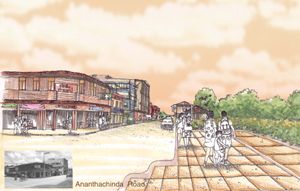 The use of Thai and Canadian graduate
students in the Phimai demonstration has resulted in the production of a situational
analysis of the municipality, as well as computer-aided graphic depictions of key
strategic areas. Using the situational analysis as a basis for setting the context of
Phimai's opportunities and constraints, the TTTP team developed an activity timeline for
its deliverables (i.e., tourism development and museum options). These options will be
offered to the regional office for consideration. The computer-aided images generated by
Chulalongkorn University graduates will assist the regional office in this process as a
tool for visual representations of Phimai's commercial area, historical site, and its
physical linkage to the museum. The images will be used in public discussions and
stakeholders' meetings for focusing dialogue on the relevant aspects of improving Phimai's
economic development (e.g., how to improve tourists' main street experience). The use of Thai and Canadian graduate
students in the Phimai demonstration has resulted in the production of a situational
analysis of the municipality, as well as computer-aided graphic depictions of key
strategic areas. Using the situational analysis as a basis for setting the context of
Phimai's opportunities and constraints, the TTTP team developed an activity timeline for
its deliverables (i.e., tourism development and museum options). These options will be
offered to the regional office for consideration. The computer-aided images generated by
Chulalongkorn University graduates will assist the regional office in this process as a
tool for visual representations of Phimai's commercial area, historical site, and its
physical linkage to the museum. The images will be used in public discussions and
stakeholders' meetings for focusing dialogue on the relevant aspects of improving Phimai's
economic development (e.g., how to improve tourists' main street experience).
Early Findings and Issues
There is no doubt that the objectives identified by the regional office will require in
some cases significant investments. While various levels of government may invest in
infrastructure development and improvements to the heritage environments, there will have
to be strategies developed to secure new and additional revenues. One of the tasks for
both the project team and the Department of Fine Arts is to look at options that will
provide incentives for the community as well as the heritage sites to increase visitation.
Part of the challenge is to determine how to channel the tourism revenue into site
operations and improvements as well as fund improvements to the community and environment.
A range of techniques will be presented and assessed to explore how this might be done.
There is no doubt that the ability of the heritage sites to collect gate receipts and use
them for their own purposes is an important first step. There are numerous models for
doing this and these will be explored as part of the larger demonstration process.
Gaining the interest and involvement of Phimai's business community is crucial in
Phimai's tourism development process. Indeed, commercial area improvement, a rejuvenated
handicrafts industry, and recognition of the importance of re-investing in the community
require an informed and participatory private sector.
There will be a need to carry out economic development studies that can be presented to
the business community to demonstrate the benefit of tourism not only to them but also to
the larger community. Research clearly indicates that a community with successful tourism
can also benefit in terms of its increased profile for other economic development
purposes.
Next Steps
The nature of the issues in Phimai indicates that a concerted and united community
effort is required to achieve the objectives outlined by the regional office. While a
full-fledged exercise in community participation involving all interest groups is beyond
the scope of the TTTP demonstration, it is the TTTP's objective over the next six months
to assist in identifying feasible strategies to strengthen Phimai's economic and tourism
development and management. Through information sessions (such as the VR seminar),
perspectives of various locations in Phimai, and tourism and museum options, the TTTP
expects to provide the regional office with a foundation for community dialogue and
sustainable development. The Project will also have to work on schemes for the alleviation
of pollution, dealing with the problems of traffic circulation and congestion around the
sanctuary site and finding suitable parking that does not have negative impacts on
surrounding land uses. Further, the notion of Phimai forming part of a destination
"circuit" with Khorat and Klong Khwang will be emphasized.
Conclusion and Recommendations
The community objectives in both Phimai and Klong Khwang are related to economic
development and increased resources for heritage conservation. There is also in each case
a goal to tell the stories of the individual sites as well as of the larger community. The
principle of sustainability makes reaching these goals and objectives challenging. We
enter the next phase of our project with a number of questions including:
- How can archeological sites be effectively interpreted for tourism purposes without
destroying the very resources themselves? Experience has shown that excavated sites, while
very popular with tourists, present significant management and conservation problems.
- How can the interpreted values of sites be enhanced with the use of new technology,
thereby protecting the resources while increasing of the value of the tourism product to
the visitor?
- How can different heritage resources in a region be combined into a circuit that will
help to ensure a more viable tourism product?
- How can communities develop participation models that allow for broad-based
communication and involvement in the entire tourism development process?
How can tourism benefit not only the industry itself but also the entire community and the
preservation and interpretation of resources?
- What economic impact assessment tools, well-suited to the particular characteristics of
a given community, can be developed?
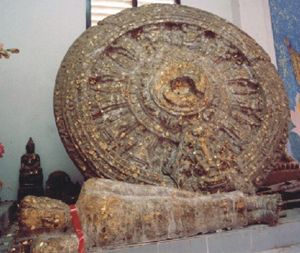 Answering all of these questions will
help to develop tourism destination strategies that effectively meet community objectives.
In assessing the economic impacts of tourism, the TTTP will follow the work of others in
considering a range of values regarding tourism and heritage resources for the community.
The work of Ismail Serageldin in Very Special Places: The Architecture and Economics of
Intervening in Historic Cities is especially valuable for this task. Answering all of these questions will
help to develop tourism destination strategies that effectively meet community objectives.
In assessing the economic impacts of tourism, the TTTP will follow the work of others in
considering a range of values regarding tourism and heritage resources for the community.
The work of Ismail Serageldin in Very Special Places: The Architecture and Economics of
Intervening in Historic Cities is especially valuable for this task.
These two demonstration projects, we hope, will yield important lessons for community
participation and decision-making, sustainable product development, and assessing the
economic benefits of tourism not only to heritage resources but also to the communities
themselves. The results of all our tourism work will be reported and discussed at the CUC
Conference on Sustainable Urban Tourism Destination Management in November 2000. The
emphasis of this conference will be on practical and applicable solutions to real-world
problems, responsible processes for the conservation and development of local natural and
human resources, and modern technologies that work and contribute to the sustainability of
all aspects of tourism in the urban environment.
References
Jamieson, Walter & Jamal, Tazim. "Contributions of Tourism to Economic
Development." International Tourism: A Global Perspective; Gee, Chuck &
Fayos-Sola, Eduardo, eds. Madrid: World Tourism Organization, 1997.
Notes
- The CUC is comprised of the Universities of British Columbia, Calgary, Montreal,
Waterloo and York. (return to document)
- The TTTP is involved in three key activities: research, training and demonstration
activities. For the purposes of this paper, however, only the demonstration activities
will be discussed. (return to document)
- The TTTP team refers to the project leader, coordinator, and various Canadian experts,
as well as both Thai and Canadian graduate students. (return to
document)
- Both Klong Khwang and Phimai form part of a tourism destination, with the city of Khorat
serving as the "Gateway to the Northeast." (return to
document)
- Klong Khwang currently receives small tour groups (approximately 10 people each) that
book in advance with the TAT. Income from these tours averages 10,000 Baht per month. (return to document)
- The suggestion to conduct a mock tourism day was given by Father Pibul Visitnondachai
(Director, Social Action Centre, Bangkok). (return to document)
© 1999, Canadian Universities Consortium
|
  |



